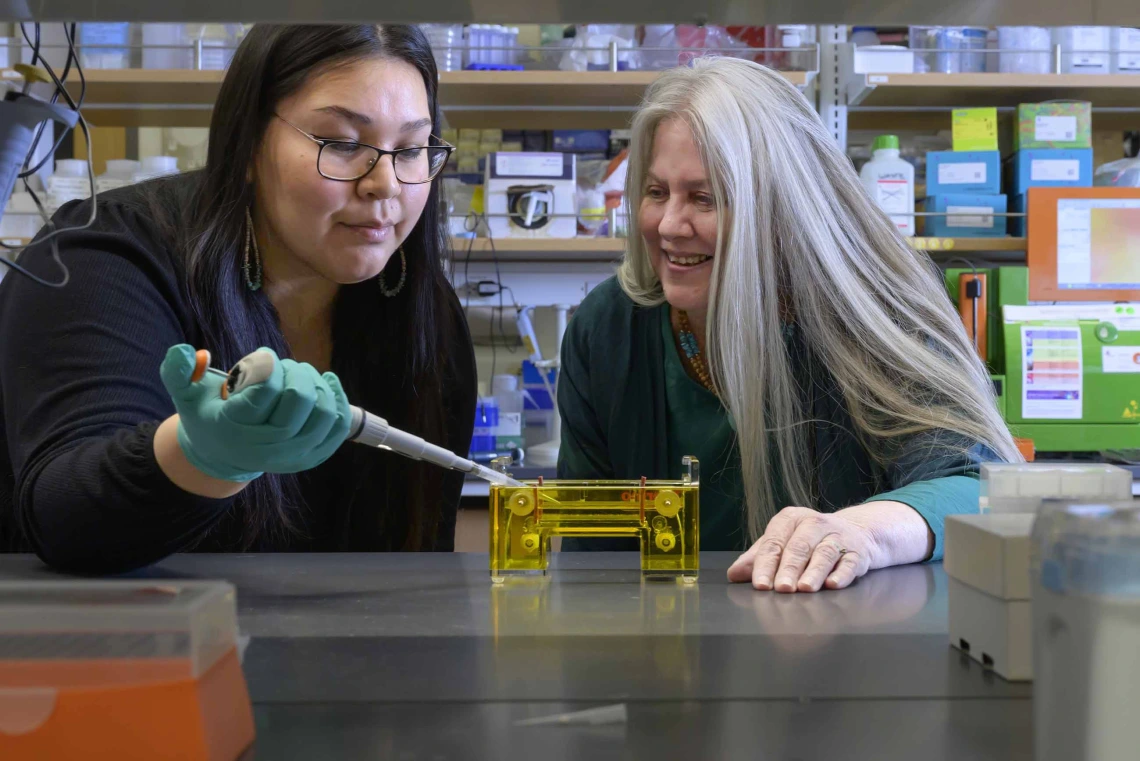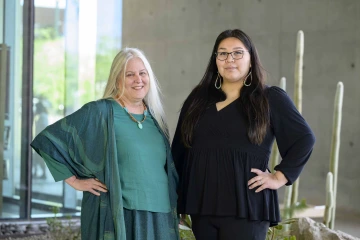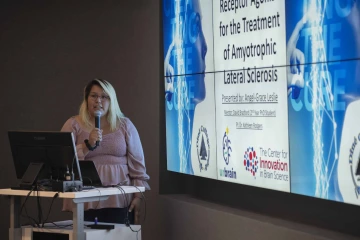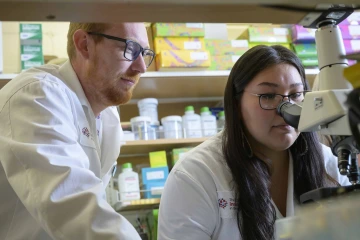Advancing Alzheimer’s research and taking knowledge home
The Center for Innovation in Brain Science is developing a diverse workforce of future scientists to fill critical gaps in Alzheimer’s disease research.

(From left) Angel-Grace Charity Leslie is researching neuroinflammation as a measurement of Alzheimer’s disease progression under the guidance of Kathleen Rodgers, PhD.
Photo by Kris Hanning, UArizona Health Sciences Office of Communications
Growing up on the Navajo Nation, Angel-Grace Charity Leslie’s life revolved around family. She took after her grandmother when it came to a love of nature, and she shared a special bond with her oldest brother.

Kathleen Rodgers, PhD, and Angel-Grace Charity Leslie’s mentoring relationship started during the URBRAIN program and continues through AZ-TRADD.
Photo by Kris Hanning, UArizona Health Sciences Office of Communications
Sadly, her brother developed epilepsy while she was in elementary school.
“I was with him the first time he had a seizure. That’s when we started going to doctor’s appointments and neurology exams,” she said. “He was very sick while I was growing up and suddenly passed away in 2020. I wanted to help him and people like him. That’s what got me here.”
“Here” is the University of Arizona Health Sciences, where Leslie, a medical pharmacology doctoral candidate at the College of Medicine – Tucson is part of a unique training program at the Center for Innovation in Brain Science. Her drive to understand the brain’s connection to epilepsy led her to mentor Kathleen Rodgers, PhD, the center’s associate director of translational neuroscience and a professor of pharmacology at the College of Medicine – Tucson.
Leslie first visited UArizona Health Sciences in 2019, when she was an undergraduate student studying biology at Diné College, the nation’s first tribal college. She was one of several students who participated in the Undergraduate Readying for Burgeoning Research for American Indian Neuroscientists program, a collaborative partnership with Diné College funded by a $1.3 million National Institutes of Health grant.
URBRAIN was designed to encourage interest in neuroscience among Native American students and create a pipeline of Navajo students to advance from Diné College to neuroscience programs at top-tier research universities, including the University of Arizona.
“URBRAIN is really where I got my start with data science. This program and my mentors really molded me and made my work now as a graduate student possible,” said Leslie, who is the first URBRAIN participant to enroll at the University of Arizona.
Her current research is funded in part by another NIH training grant, Translational Research in Alzheimer’s Disease and AD-Related Dementias, or AZ-TRADD. The program is co-led by Rodgers and Roberta Diaz Brinton, PhD, director of the Center for Innovation in Brain Science and a professor of pharmacology.
Laying the groundwork to discover treatments
Alzheimer’s disease is the seventh leading cause of death in the United States and is the most common cause of dementia among older adults, according to the National Institute on Aging. Native Americans are more likely to develop Alzheimer’s disease or other forms of dementia than white or Asian Americans, according to the Alzheimer’s Association.

(From left) At the end of the URBRAIN program, Leslie presented her research to faculty and peers.
Photo by Noelle Haro-Gomez, UArizona Health Sciences Office of Communications
In a healthy brain, billions of nerve cells, or neurons, process and transmit information through electrical and chemical signals. These neurons work together to send messages to different parts of the brain and to organs and muscles throughout the body. When neurons are unable to work together, the result is a loss of brain function as seen in Alzheimer’s disease.
Amyloid plaques are a hallmark of Alzheimer’s disease. The immune system clears these sticky bits of protein without incident in a healthy brain. In people with Alzheimer’s, though, the plaques clump between neurons in the brain and disrupt normal cell-to-cell communication, resulting in memory loss and cognitive decline that eventually makes life-sustaining tasks like swallowing food increasingly difficult.
“We normally think of our immune system fighting off invaders like viruses and bacteria, but in this case, the immune system is treating the plaques as the invaders,” Rodgers said. “Normally, immune cells work to wall off and clear these plaques, but in Alzheimer’s disease they can’t keep up. This causes chronic inflammation, which can damage and even cause death to neurons. The immune cells themselves can become inflamed and unable to do the job they are supposed to do.”
Leslie is working with mouse models of Alzheimer’s disease to observe the actions of immune cells and the resulting inflammatory response in hopes that the information can be used as a measurement of disease progression.
“By creating a model for inflammation over time, researchers might be able use it as a baseline to determine at what stage of Alzheimer’s disease their therapeutic is most effective,” Leslie said.
Passing down and sharing knowledge

Graduate research assistant David Bradford mentored Leslie when she participated in URBRAIN and helped make her transition to the University of Arizona a smooth one.
Photo by Kris Hanning, UArizona Health Sciences Office of Communications
“Angel is doing great work. The immune system is one of the most challenging systems to work with. It can almost make the bioenergetic systems of the brain look simple,” Brinton said, adding that Leslie is a great representative for URBRAIN and AZ-TRADD.
“The AZ-TRADD program was our center’s first training grant, and it has led the way for our subsequent training grants for undergraduates and junior faculty.”
As part of AZ-TRADD, students take courses ranging from bioinformatics to coding to the ethics of leadership. The program also involves a mentoring opportunity with URBAIN participants, which provides Leslie the opportunity to pass down some of what she learned to a current Diné College student.
“This university is a big place, and it could have been really daunting for me coming in as an undergraduate,” she said. “I was really lucky to have a smooth transition. David Bradford, who was a graduate student I worked with while in URBRAIN, was a big part of that. He was and continues to be a great mentor. If I can be that for someone else, I think that is really special.”
For Leslie, the training programs not only serve as steppingstones to a future career, but also are part of a journey toward helping a community she loves.
“Back home we have a saying: ‘Go into the world, learn as much as you can and bring it back’,” Leslie said. ‘Knowing that I might be able to bring this critical knowledge back to the Navajo Nation gives me a lot of pride.”
Experts
Kathleen Rodgers, PhD
Associate Director, Translational Neuroscience, Center for Innovation in Brain Science, UArizona Health Sciences
Professor, Department of Pharmacology, College of Medicine – Tucson
Professor, Clinical Translational Sciences, College of Health Sciences
Member, BIO5 Institute
Roberta Diaz Brinton, PhD
Director, Center for Innovation in Brain Science, UArizona Health Sciences
Professor, Department of Pharmacology, College of Medicine – Tucson
Professor, Department of Neurology, College of Medicine – Tucson
Professor, Evelyn F McKnight Brain Institute
Professor, Department of Psychology, College of Science
Professor, Department of Pharmacology and Toxicology, R. Ken Coit College of Pharmacy
Professor, Clinical Translational Sciences, College of Health Sciences
Member, BIO5 Institute
Contact
Brian Brennan
UArizona Health Sciences Office of Communications
520-621-3510, brianbrennan@arizona.edu

